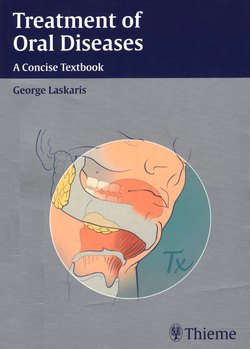Читать книгу Treatment of Oral Diseases - George Laskaris - Страница 16
ОглавлениеAmyloidosis
Definition
Amyloidosis is a rare metabolic disorder characterized by an abnormal extracellular deposition of amyloid, a fibrillar proteinaceous material, in tissues.
Etiology
The etiology of amyloidosis is not fully understood.
Classification
Four major types of amyloidosis are recognized: primary, secondary, familial, and senile. Primary and secondary amyloidosis may be either systemic or localized.
Main Clinical Features
The oral mucosa is usually involved (30-50%) in primary systemic amyloidosis, while oral lesions are rare in the secondary form.
Oral Lesions
•Petechiae, ecchymoses, papules, nodules, swellings
•Macroglossia, ulcers
•Salivary gland infiltration
•Xerostomia and rarely bullae
•The deep red hue is characteristic of all oral lesions
Skin Lesions
•Purpura, petechiae, papules, nodules, macules
•Ulcers, hemorrhage, bullae
•Alopecia
•Waxy discoloration of the skin
•Periorbital ecchymoses
Systemic Manifestations
•Fatigue, weakness, weight loss, edema, dyspnea, hoarseness, bleeding, pain
•Carpal tunnel syndrome
•Heart, renal, joints, skeletal muscles, gastrointestinal tract, nervous system and other organ involvement
•Multiple myeloma may be associated with 10-20% of cases of primary systemic amyloidosis
Diagnosis
The clinical diagnosis should be confirmed by a biopsy and histopathologic examination with special stains (Congo red. methyl violet, thioflavine T).
Differential Diagnosis
•Lipoid proteinosis
•Sarcoidosis
•Crohn disease
•Multiple neurofibromatosis
•Lupus vulgaris
•Pemphigus
•Bullous pemphigoid
•Macroglossia due to other causes
Treatment
Basic Guidelines
•There is no specific therapy.
•The treatment is usually aimed at alleviating the symptoms and does not lead to removal of the amyloid deposits.
•The treatment of oral lesions is also symptomatic and usually unsuccessful.
•Amyloidosis must be treated by a specialist.
Suggested Therapies
Topical Treatment
•High level of oral hygiene is necessary.
•Topical corticosteroids and immunomodulators (e.g., tacrolimus) are useful, particularly in cases with oral ulcerations.
•Antiseptic rinses may be used in cases of infection of oral lesions.
Systemic Treatment
Primary Amyloidosis
Primary amyloidosis (AL), in particular of the kidney, is treated with alkylating agents (e.g., melphalan) and corticosteroids. This treatment can reduce the proteinuria and improve renal function in a few patients. The administration of a new anthracycline (4′-iodo-4′-deoxydoxoru-bicin) can also induce rapid improvement in some patients. The effectiveness of anthracycline is attributed to the binding of the drug to the amyloid fibrils. Bleeding diathesis can be treated with high-dose melphalan chemotherapy and autologous bone marrow transplantation.
Secondary Amyloidosis
Secondary amyloidosis (AA) with renal or hepatic involvement due to familial Mediterranean fever is treated with colchicine 0.6 mg twice daily, which prevents or arrests further progression of the disease process. In patients with chronic he-modialysis-related amyloidosis, renal transplantation is considered. Renal transplantation is also an option in patients with secondary amyloidosis. Adequate control of inflammation early in the course of rheumatoid arthritis may prevent the development of secondary amyloidosis or slow the progression of organ failure if this complication has already developed. Cytotoxic drugs (e.g., chlorambucil) may reduce the frequency of AA.
Alternative Therapies
Dimethyl sulfoxide (DMSO), which may partially dissolve amyloid fibrils has been shown to be effective in some patients with AA. but the resultant body odor makes it unacceptable and thus currently it is only used topically in patients with extensive cutaneous amyloidosis. A new approach to the treatment of systemic amyloidosis and other diseases associated with local amyloid is with a new compound called car-boxy-pyrrolidin-oxo-hexanoyl pyrrolidine-car-boxylic acid (CPHPC). This is a competitive inhibitor of serum amyloid P component (SAP) binding to amyloid fibrils, resulting in the removal of SAP from amyloid deposits in the tissues.
References
Baxbaum J. The amyloidoses. In: Klippel JH, Dieppe PA (eds). Rheumatology, 2nd edition. Mosby: London, 1998; pp.8.27.1–18.27.10.
Cunnane G, Whitehead AS. Amyloid precursors and amyloidosis in rheumatoid arthritis. Bailliere’s Clin Rheumatol 1999;13:615–628.
Haukins PN. Hereditary systemic amyloidosis with renal involvement. J Nephrol 2003;16:443–448.
Merlini G, Anesi E, Garini P, et al. Treatment of AL amyloidosis with 4’-iodo-4’-deoxydoxorubicin: An update. Blood 1999;93:1112–1113.
Pepys MB, Herbert J, Hutchinson WL, et al. Targeted pharmacological depletion of serum amyloid P component for treatment of human amyloidosis. Nature 2002;417:254–259.
Skinner M, Sanchorawala V, Seldin DC, et al. High-dose melfalan and autologous stem-cell transplantation in patients with AL amyloidosis: An 8-year study. Ann Intern Med 2004;140:85–93.
Stoopler ET, Sollecito TP, Chen SY. Amyloid deposition in the oral cavity: A retrospective study and review of the literature. Oral Surg Oral Med Oral Pathol Oral Radiol Endod 2003;95:674–680.
Suhr OB, Svendsen IH, Andersson R, et al. Hereditary transthyretin amyloidosis from a Scandinavian perspective. J intern Med 2003;254:225–235.
